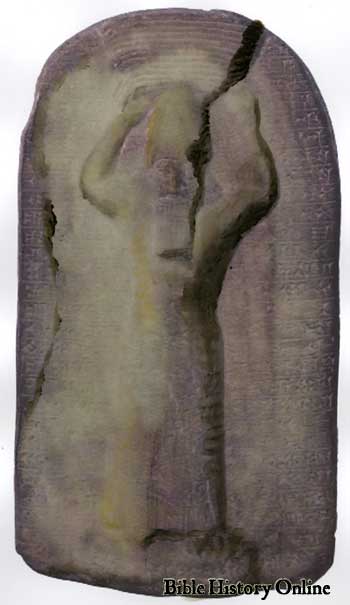Stela of Ashurbanipal

Could this relief be
reminiscent of king Solomon who was personally involved in the dedication of
the Temple in Jerusalem?
This relief of Ashurbanipal (668-626 B.C.) from Nineveh reveals the king carrying a basket on his head, symbolizing the kings personal involvement in the restoration of the temple of Esagila in Babylon.
King Ashurbanipal is reminiscent of king Solomon who was personally involved in the construction of the Temple of Yahweh in Jerusalem. One generation later the Babylonians came and destroyed proud Assyria and the Assyrian Empire passed into history. The Stela of Ashurbanipal discovery is important in the study of Biblical Archaeology.
"Woe to Assyria, the rod of My anger And the staff in whose hand is My indignation. I will send him against an ungodly nation, And against the people of My wrath I will give him charge, To seize the spoil, to take the prey, And to tread them down like the mire of the streets. Yet he does not mean so, Nor does his heart think so; But it is in his heart to destroy, And cut off not a few nations. For he says, "Are not my princes altogether kings? Is not Calno like Carchemish? Is not Hamath like Arpad? Is not Samaria like Damascus? As my hand has found the kingdoms of the idols, Whose carved images excelled those of Jerusalem and Samaria, As I have done to Samaria and her idols, Shall I not do also to Jerusalem and her idols?"' Therefore it shall come to pass, when the Lord has performed all His work on Mount Zion and on Jerusalem, that He will say, "I will punish the fruit of the arrogant heart of the king of Assyria, and the glory of his haughty looks." For he says: "By the strength of my hand I have done it, And by my wisdom, for I am prudent; Also I have removed the boundaries of the people, And have robbed their treasuries; So I have put down the inhabitants like a valiant man." Isaiah 10:5-13
Material - Black Limestone Obelisk
Neo Assyrian
Date: 669-655 BC
Language: Cuneiform
Height: 37 cm
Width: 22 cm
Depth: 10 cm
Babylon, southern Iraq
Excavated by: Robert Koldeway 1899-1917
Location: British Museum, London
Item: ANE 90864 (1881.3-24.367)
Room: 55, Later Mesopotamia, case 11
British Museum Excerpt
Stela of Ashurbanipal
Neo-Assyrian, about 669-655 BC
From Babylon, southern Iraq
The king carrying a basket on his head
The city of Babylon had been destroyed by the Assyrian king Sennacherib in 689 BC but was rebuilt by his son Esarhaddon (reigned 680-669 BC) and grandson Ashurbanipal (reigned 669-631 BC). One of the duties of a Mesopotamian king was to care for the gods and restore or rebuild their temples. Much earlier, in the late third millennium BC, rulers in southern Mesopotamia depicted themselves carrying out this pious task in the form of foundation pegs, such as the copper figure of Ur-Nammu (reigned 2112-2095 BC), also in The British Museum.
It is possible that similar figurines were discovered in the ruins of Babylon during Ashurbanipal's rebuilding works. For on this stela, Ashurbanipal, wearing the Assyrian king's head-dress, is shown in the pose of earlier kings, lifting up a large basket of earth for the ritual moulding of the first brick.
The cuneiform inscription around and over the king's body records his restoration of the shrine of Ea, the god of fresh water and wisdom, within the Temple of Marduk, the supreme deity of Babylon.
The British Museum
List of Assyrian Kings
Assur-nasipal II (885-860 B.C.) A cruel warrior king, he made Assyria into the most fierce fighting machine of ancient world.
Shalmaneser II (860-825 B.C.) he was the first Assyrian king to come into conflict with Israel. King Ahab fought against him, and king Jehu paid him tribute.
Shansi-adad (825-808 B.C.) Assyria in decline
Adad-nirari (808-783 B.C.) Assyria in decline
Shalmaneser III (783-771 B.C.) Assyria in decline
Assur-dayan (771-753 B.C.) Assyria in decline
Assur-lush (753-747 B.C.) Assyria in decline
Tiglath-pileser III (Pul) (747-727 B.C.) He carried the Northern Kingdom of Israel into captivity.
Shalmaneser IV (727-722 B.C.) He besieged Samaria and died during the siege.
Sargon II (722-705 B.C.) He completed the destruction of Samaria and the captivity of Israel.
Sennacherib (705-681 B.C.) He was the most famous of the Assyrian kings, he mentions the name of Hezekiah on his prism. His army was defeated at the gates of Jerusalem by the Angel of the Lord. He also conquered Babylon.
Esar-haddon (681-668 B.C.) He rebuilt Babylon and conquered Egypt. He was one of Assyria's greatest kings.
Assur-banipal (668-626 B.C.) He destroyed the Thebes in Egypt and collected a great library, innumerable clay tablets were found.
Assur-etil-ilani (626-607 B.C.) It was under his reign that the Assyrian Empire fell.
Assyrian annals mention contacts with some ten Hebrew kings: Omri, Ahab, Jehu, Menahem, Hoshea, Pekah, Uzziah, Ahaz, Hezekiah, and Manasseh.
Related Pages:
Ashurbanipal in the Bible Encyclopedia
Ashurbanipal Glossary Definition
Lachish in Easton's Bible Dictionary
Biblical Archaeology: Assyria
Archaeology of Ancient Assyria - Archaeological Discoveries
Ancient
Near East - Images and Art
Free Bible - Fallen Empires (Biblical Archaeology)
Bible History Links - Ancient Near East : Art & Images
Free Bible - Ancient Art
Assyria and Bible Prophecy - Timeline of Events
Ancient History Timeline
The Destruction of Israel - Kings of Israel, Judah and Assyria
Archaeology of Ancient Assyria - Khorsabad
Timeline 800 - 700 BC
The Assyrians
The Captivity
Archaeology of Ancient Assyria - Calah
Ancient Babylonia - Nimrud
Archaeology of Ancient Assyria - Austen Henry Layard
Archaeology of Ancient Assyria - Ancient Assyria
International Standard Bible Encyclopedia - Calah
Ancient Sketches
Read The Bible
- 1599 Geneva Bible (GNV)
- 21st Century King James Version (KJ21)
- American Standard Version (ASV)
- Amplified Bible (AMP)
- Amplified Bible, Classic Edition (AMPC)
- Authorized (King James) Version (AKJV)
- BRG Bible (BRG)
- Christian Standard Bible (CSB)
- Common English Bible (CEB)
- Complete Jewish Bible (CJB)
- Contemporary English Version (CEV)
- Darby Translation (DARBY)
- Disciples’ Literal New Testament (DLNT)
- Douay-Rheims 1899 American Edition (DRA)
- Easy-to-Read Version (ERV)
- English Standard Version (ESV)
- English Standard Version Anglicised (ESVUK)
- Evangelical Heritage Version (EHV)
- Expanded Bible (EXB)
- GOD’S WORD Translation (GW)
- Good News Translation (GNT)
- Holman Christian Standard Bible (HCSB)
- International Children’s Bible (ICB)
- International Standard Version (ISV)
- J.B. Phillips New Testament (PHILLIPS)
- Jubilee Bible 2000 (JUB)
- King James Version (KJV)
- Lexham English Bible (LEB)
- Living Bible (TLB)
- Modern English Version (MEV)
- Mounce Reverse Interlinear New Testament (MOUNCE)
- Names of God Bible (NOG)
- New American Bible (Revised Edition) (NABRE)
- New American Standard Bible (NASB)
- New American Standard Bible 1995 (NASB1995)
- New Catholic Bible (NCB)
- New Century Version (NCV)
- New English Translation (NET)
- New International Reader's Version (NIRV)
- New International Version - UK (NIVUK)
- New International Version (NIV)
- New King James Version (NKJV)
- New Life Version (NLV)
- New Living Translation (NLT)
- New Matthew Bible (NMB)
- New Revised Standard Version (NRSV)
- New Revised Standard Version Catholic Edition (NRSVCE)
- New Revised Standard Version, Anglicised (NRSVA)
- New Revised Standard Version, Anglicised Catholic Edition (NRSVACE)
- New Testament for Everyone (NTE)
- Orthodox Jewish Bible (OJB)
- Revised Geneva Translation (RGT)
- Revised Standard Version (RSV)
- Revised Standard Version Catholic Edition (RSVCE)
- The Message (MSG)
- The Voice (VOICE)
- Tree of Life Version (TLV)
- World English Bible (WEB)
- Worldwide English (New Testament) (WE)
- Wycliffe Bible (WYC)
- Young's Literal Translation (YLT)
Main Menu
- Ancient Assyrian Social Structure
- Ancient Babylonia
- Ancient Canaan During the Time of Joshua
- Ancient History Timeline
- Ancient Oil Lamps
- Antonia Fortress
- Archaeology of Ancient Assyria
- Assyria and Bible Prophecy
- Augustus Caesar
- Background Bible Study
- Bible
- Biblical Geography
- Fallen Empires - Archaeological Discoveries and the Bible
- First Century Jerusalem
- Glossary of Latin Words
- Herod Agrippa I
- Herod Antipas
- Herod the Great
- Herod's Temple
- High Priest's in New Testament Times
- Jewish Literature in New Testament Times
- Library collection
- Map of David's Kingdom
- Map of the Divided Kingdom - Israel and Judah
- Map of the Ministry of Jesus
- Matthew Henry Bible Commentary
- Messianic Prophecy
- Nero Caesar Emperor
- Online Bible Maps
- Paul's First Missionary Journey
- Paul's Second Missionary Journey
- Paul's Third Missionary Journey
- Pontius Pilate
- Questions About the Ancient World
- Tabernacle of Ancient Israel
- Tax Collectors in New Testament Times
- The Babylonian Captivity
- The Black Obelisk of Shalmaneser
- The Books of the New Testament
- The Court of the Gentiles
- The Court of the Women in the Temple
- The Destruction of Israel
- The Fall of Judah with Map
- The History Of Rome
- The Incredible Bible
- The Jewish Calendar in Ancient Hebrew History
- The Life of Jesus in Chronological Order
- The Life of Jesus in Harmony
- The Names of God
- The New Testament
- The Old Testament
- The Passion of the Christ
- The Pharisees
- The Sacred Year of Israel in New Testament Times
- The Samaritans
- The Scribes
Ancient Questions
- Why Do the Huldah Gates Appear Different in Ancient Replicas and Modern Photos?
- What Is the Origin of the Japanese and Chinese Peoples? A Biblical Perspective
- How did the ancient Greeks and Romans practice medicine and treat illnesses?
- What were the major contributions of ancient Babylon to mathematics and astronomy?
- How did the ancient Persians create and administer their vast empire?
- What were the cultural and artistic achievements of ancient India, particularly during the Gupta Empire?
- How did ancient civilizations like the Incas and Aztecs build their remarkable cities and structures?
- What were the major trade routes and trading practices of the ancient world?
- What was the role of slavery in ancient societies like Rome and Greece?
- How did the ancient Mayans develop their sophisticated calendar system?
Bible Study Questions
- Why Do Christians Celebrate Christmas?
- How Many Chapters Are There in the Bible?
- The Five Key Visions in the New Testament
- The 400-Year Prophecy: Unpacking Genesis 15 and the Journey of a People
- The Authorized (King James) Version (AKJV): Historical Significance, Translation Methodology, and Lasting Impact
- Exploring the English Standard Version (ESV): Its Aspects, Comparisons, Impact on Biblical Studies, and Church Use
- A Detailed Historical Analysis of Language Updates in the KJ21: Comparison with Other Versions
- A Detailed Historical Analysis of the American Standard Version (ASV): Comparison to the King James Version, Influence on Later Translations, and Evaluation of Strengths and Weaknesses
- A Detailed Historical Analysis of Amplifications in the Amplified Bible (AMP) and Its Comparison to Other Bible Translations
- Detailed Historical Analysis of the Amplified Bible Classic Edition (AMPC): Examples of Amplifications and Comparative Analysis with Other Bible Translations
About
Welcome to Free Bible: Unearthing the Past, Illuminating the Present! Step into a world where ancient history and biblical narratives intertwine, inviting you to explore the rich tapestry of human civilization.
Discover the captivating stories of forgotten empires, delve into the customs and cultures of our ancestors, and witness the remarkable findings unearthed by dedicated archaeologists.
Immerse yourself in a treasure trove of knowledge, where the past comes alive and illuminates our understanding of the present.
Join us on this extraordinary journey through time, where curiosity is rewarded and ancient mysteries await your exploration.
Recent posts
-

How to Choose the Perfect Christian Living Community
Did you know that two-thirds of Americans identify as Christians and more than half of those attend religious services more than once a month? When se... -

How to Build a Modern Slot Machine Engine: Math Models and RTP Design
Introduction: The Heart of Modern Slots Slot machines have evolved tremendously since the first mechanical reels appeared in the 1890s. Digital techno... -

Why Discipleship Ministries Matter: How They Shape Churches and Communities
Discipleship ministries have traditionally played an important role in Christians' spiritual growth and the long-term viability of their churches. Chr... -

A Historical Journey of Health Insurance: From Ancient Mutual Aid to Modern Coverage
The modern form of health insurance, which is premium based, pooled risk financial coverage during illness is a relatively new development. But the th... -

Get a Crypto License in Poland - Secure, EU-Ready, and Backed by Prifinance Expertise
Expand your crypto business legally in the European Union with a crypto license in Poland under the MiCA framework. Poland has become one of the most ...
